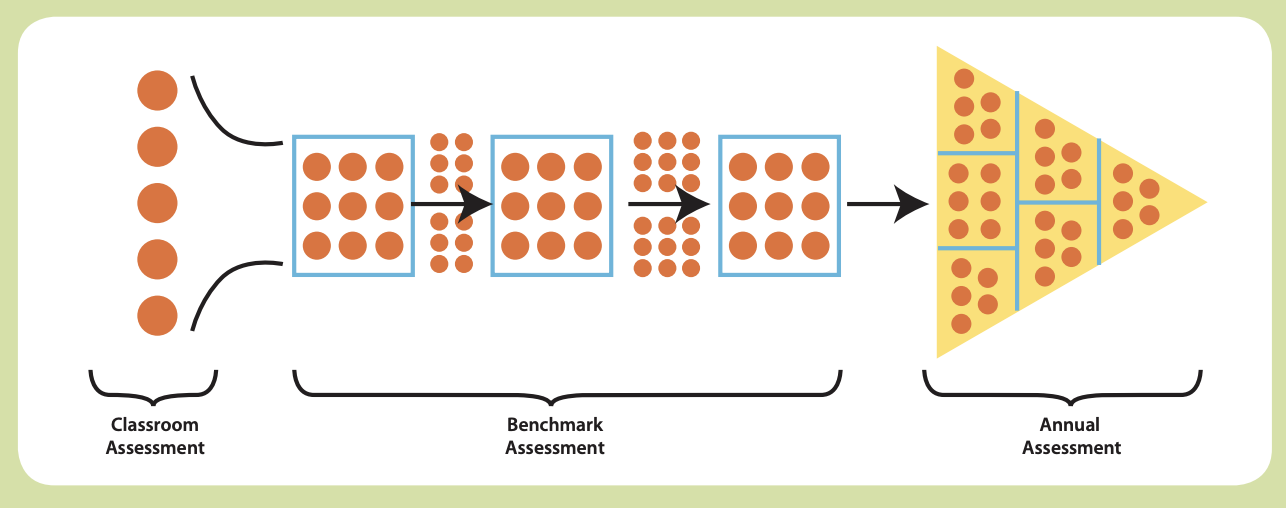Benchmark assessments, otherwise known as interim assessments, are typically administered at multiple points throughout the academic year as a “checkpoint” providing teachers with valuable data on student progress and areas of need. These assessments are designed to align with state or district standards, ensuring that the content students are learning in the classroom is effectively preparing them for success in these areas.

Benchmark assessments fall somewhere between daily or weekly classroom assessments and annual assessments. The Assessment and Accountability Comprehensive Center’s article about Benchmark Assessment for Improved Learning states:
"While annual state assessments provide a general indicator of how students are doing relative to annual learning standards, and while traditional formative assessment is embedded in ongoing classroom instruction to inform immediate teaching and learning goals, benchmark assessments occupy a middle position strategically administered outside daily classroom use but inside the school and/or district curriculum.”

There are many variations of benchmark assessments. Formative and performance tests can also be used as benchmark assessments. Let’s take a closer look at some types of assessments that can be benchmarks:
These are assessments given at the end of a unit or chapter in a textbook. They're designed to measure student understanding of the specific material covered in that unit.
These are short tests given multiple times throughout the year to gather continuous feedback on how students are learning the material. They're often used to identify areas where students are struggling so that teachers can adjust their instruction accordingly. These informal assessments can also be benchmarks to track student progress.
These require students to perform a task rather than answer questions. They're often used in subjects like science and social studies, where students might be asked to conduct an experiment or create a presentation.
These are interactive assessments that adjust the difficulty of questions based on the student's responses. This helps provide a more accurate picture of a student's ability level. Many CAASPP Practice Tests fall into this category.
You may notice that many types of assessments can also be benchmark tests. The lines between these types of assessments can sometimes blur, so what are the defining characteristics of a benchmark? Here is how they stand out in comparison to other types of assessments:
Benchmark assessments are used in a variety of educational settings, from elementary schools to high schools. A third grade teacher might use a benchmark assessment in math at the beginning of the school year to determine students' understanding of basic multiplication and division. The results of this assessment would then guide the teacher's instruction, helping them tailor their lessons to meet the needs of their students. The teacher might then follow up again with this assessment in the middle of the year to see how students have progressed.
A high school English teacher might use a benchmark assessment to evaluate students' writing skills. The teacher would then use a rubric to evaluate each student's writing, providing feedback on areas like grammar, organization, and argumentation. These assessments would be administered at regular intervals, providing data on student learning and helping educators adjust their instruction as needed.
Benchmark assessments in math are designed to evaluate student understanding of key mathematical concepts and skills. These assessments can cover a range of topics, from basic arithmetic and number sense to more complex areas like algebra, geometry, and data analysis. One example of math benchmark assessments is the SBAC Math Interim Assessments. The Smarter Balanced Assessment Consortium (SBAC) is a standardized test aligned with the Common Core State Standards (CCSS). While these are summative assessments, the SBAC also offers interim assessments to check student knowledge leading up to the standardized test at the end of the year. The assessments include a mix of multiple-choice, short-answer, and extended-response questions.
In conclusion, benchmark interim assessments serve as a crucial tool for educators to gauge student understanding and progress. Ultimately, the power of benchmark assessments lies in their ability to support a culture of continuous learning and improvement. They remind us that education is not just about the destination, but also about the journey. By regularly checking in on student progress, educators can ensure that all students are on the right path toward success. Whether you're an educator seeking to enhance your instruction or a school leader aiming to improve student outcomes, benchmark assessments are an essential tool in your toolkit.